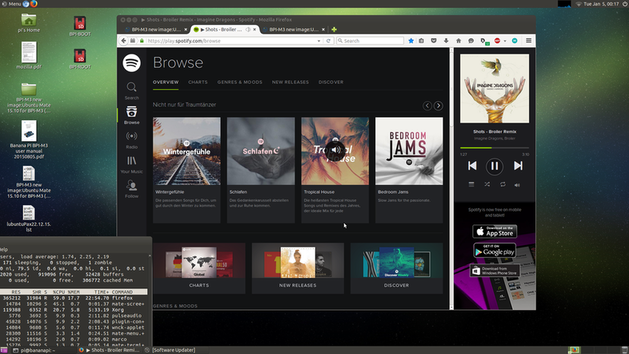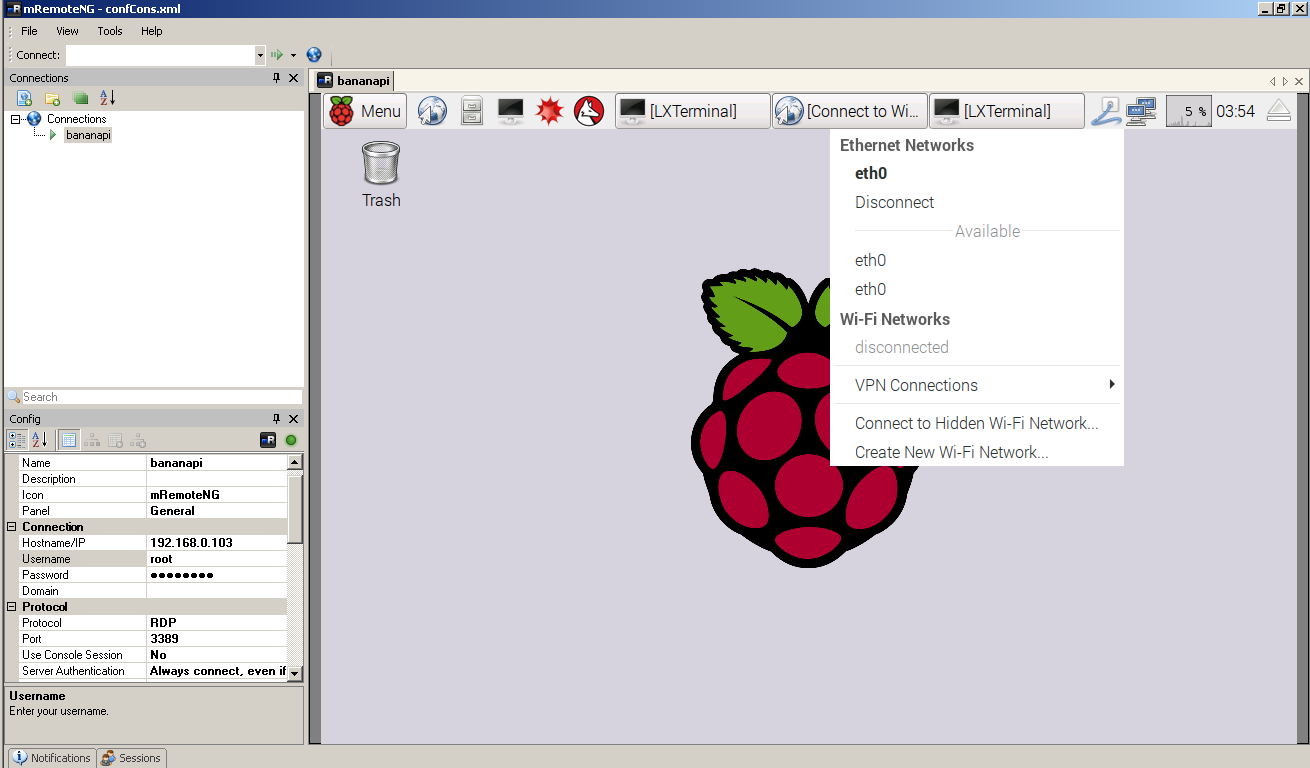Project start: Dec/30/15
Latest update: Jan/10/16
Here is a report from my M3 adventure progress:
I connect power via micro USB from my build environment notebook on the long edge next to the HDMI port or with standard 5V 2A micro USB power supply connected to the short edges socket.
Power indicator is red LED, flashes short after power on, then stays on.
If bootable medium is found, all LED (R,G,B) turn on for a short time instant.
If booting is successfully running, green LED blinks twice - pause - twice - … (heartbeat).
If your display is supported out of the box, you’ll see a grey splash screen with bpi logo in the center,
then the boot log follows below 8 Tux penguins at the top of the log.
The supplied Ubuntu Mate 15.10 image runs patched -see below- finally from SD card (Samsung 32 Gb Evo+) using a plain HDMI cable connected to an old Sony Bravia TV and an Acer B223w in 720p connected thru a HDMI2DVI adapter. I use a Logitech K400r wireless keyboard occupying one USB port for mouse touchpad and keyboard.
First, I prepared a build environment (always recommended for hardware tuning and patches):
sudo apt-get install build-essential u-boot-tools
I rebuilt the BSP (Dec/28/2015, zipped from github) as BPI_720p_MPI3 and patched the image burned to SD card via:
sudo dd if=ubuntu-mate-15.10-desktop-armhf-raspberry-pi-2-bpi-m3-sd-emmc-20151203.img bs=10M of=/dev/mmcblk0
as shown by others (on Linux Mint 17.3 Rosa x86_64, an Ubuntu 14.04 LTS flavour):
cd BPI-M3-bsp-master/download/BPI_M3_720P
card=/dev/mmcblk0
sudo dd if=boot0_sdcard.fex of=${card} bs=1k seek=8
sudo dd if=u-boot.fex of=${card} bs=1k seek=19096
sudo dd if=boot-resource.fex of=${card} bs=1k seek=36864
sudo dd if=env.fex of=${card} bs=1k seek=69632
sudo dd if=boot.fex of=${card} bs=1k seek=86016
sudo cp -rf lib /media/…YOURUSER…/BPI_ROOT #second “BPI_ROOT” partition (can be done with file manager, merge and overwrite: sudo nemo/nautilus, drag&drop…)
Experiments with HDMI cable, standard Belkin DVI 18+1 adapter and an old Acer B223w display have succeeded finally in 720p. As indicated by Rab, I changed some lines in BPI-M3-bsp-master/sunxi-pack/chips/sun8iw6p1/configs/BPI_M3_720P/sys_config.fex:
hdmi_hdcp_enable = 0
hdmi_cts_compatibility = 1
as found on the orangepi forum. Then I rebuilt BSP and patched again.
Regarding multimedia (spotify/deezer), pepper flash player can be copied into the system (ripped from chrome/ium OS). I partially followed steps from Lemaker forum: http://forum.lemaker.org/thread-22800-1-1.html:
wget http://odroidxu.leeharris.me.uk/repo/chromium-pepper-flash-12-12.0.0.77-1-armv7h.pkg.tar.xz
Unzip the files from archive to some folder, cd to the folder with the lib…so files, then:
sudo mkdir /usr/lib/chromium-browser/PepperFlash
sudo cp * /usr/lib/chromium-browser/PepperFlash #firefox pepper plugin looks here
sudo ln -s /usr/lib/chromium-browser/PepperFlash/* /usr/lib/chromium-browser/plugins/ #chromium looks here
sudo nano /etc/chromium-browser/default #follow the edits from lemaker forum, i.e. insert CHROMIUM_FLAGS=“–ppapi-flash-path=/usr/lib/chromium-browser/plugins/libpepflashplayer.so --ppapi-flash-version=12.0.0.77 --ppapi-flash-args=enable_hw_video_decode=1,enable_stagevideo_auto=1,enable_trace_to_console=0”
sudo apt-get install browser-plugin-freshplayer-pepperflash # this is for firefox to use pepper flash
Sound worked for me with HDMI output on the TV at some instant, later when trying headphone jack, there was just silence. Then at some instant strange noise in my first trials with alsamixer. Had to fiddle around a lot in trial and error fashion (running a sound loop in the background) in alsamixer until I get what I want. See:
http://askubuntu.com/questions/50067/howto-save-alsamixer-settings
on how to save your settings permanently. Strangely, left and right channel were switched which can be rewired in alsamixer. Its a bit tricky to get this piece of work done…
You can remove package irqbalance, according to tkaiser:
sudo apt-get remove irqbalance
Finally, I flashed the SD card image to internal emmc memory (take care just 8Gb):
sudo dd if=/dev/mmcblk0 of=/dev/mmcblk1 bs=4M
resulting in:
dd: error writing ‘/dev/mmcblk1’: No space left on device #this is fair enough
1865+0 records in
1864+0 records out
7818182656 bytes (7.8 GB) copied, 426.322 s, 18.3 MB/s
From that point you have installed your OS permanently to the M3, but have to live with the 8Gb limit of the eMMC memory. However, boot priority is on inserted SD card!
Some closing remarks:
My original downloaded image md5sum is:
b5df9b49bdf702a5da0daf74f1daf544 ubuntu-mate-15.10-desktop-armhf-raspberry-pi-2-bpi-m3-sd-emmc-20151203.img
and sha1sum:
917843010adb54bc01496aa778174602e5913ab9 ubuntu-mate-15.10-desktop-armhf-raspberry-pi-2-bpi-m3-sd-emmc-20151203.img
Open issues as seen during my work in progress:
I have the impression, WIFI is unstable, slow and disconnects some times even if the BPi-M3 is located near a Fritzbox 3131 router. Ethernet cable connection is ok. HDMI support with adapters to DVI seems problematic. Better use monitor with direct HDMI port?! Video/graphics performance is a bit slow even in 720p yet acceptable, because hardware rendering using a GPU-driver is still not enabled or available. Full screen youtube videos suck lacking acceptable frame rate, HD mp4 videos in VLC player are only viewable in a small window, quickly exhausting the 8 cores. Hardware support for video decoding is urgently needed. In my user experience, eMMC performance is not much better (if any) than my Samsung Evo+ SD Card worth $10. With a sufficiently fast SD (mine 80Mb/20Mb) you can skip eMMC installation and have more space for your OS, maybe eMMC is useful as swap partition or/and measurement data storage for some users. Overall system performance is a bit “cheesy” (not snappy) and actually below my expectations for eight cores and eMMC. For now (with Ubuntu), it is an acceptable board which has much more potential with optimized drivers (3d graphics&video on GPU!!). I guess when those drivers are ready we have another board coming to the market.
1080p looks great on my LG Flatron E2341.
Sound quality with SuperLux HD668 headphones is very good.
A WIFI antenna with uFL connector greatly improves the stability of wireless net:
http://www.ebay.com/itm/191659068074?_trksid=p2057872.m2749.l2649&ssPageName=STRK%3AMEBIDX%3AIT
Regarding performance, we should’nt expect too much. These low energy soc board cores are still behind 10 year old pentium 4 systems:

However, I am starting to like it, as now Ubuntu is running stable on this bitch of a board, puhh.
Next steps to come:
Done/success: I will transfer the image from SD to internal emmc by dd.
Done/success: Get pepper flash running from chromium OS, anybody knows a download location for a newer version than 12.0.0.77?
Done/success: Headphone jack sound issue fixed.
Done/success:Test 1080p performance with another capable monitor.
Done/success: Get a WIFI antenna for better signal.
Put the android image to eMMC, see other image forum board…
Cheers,
dre
PS: sinovoip team, please try harder and provide sound and complete step by step instructions and (your) hardware configs known to work. Don’t let your customer waste their valuable time. They might get very angry and frustrated with your product, no good publicity for your company and sales success…




